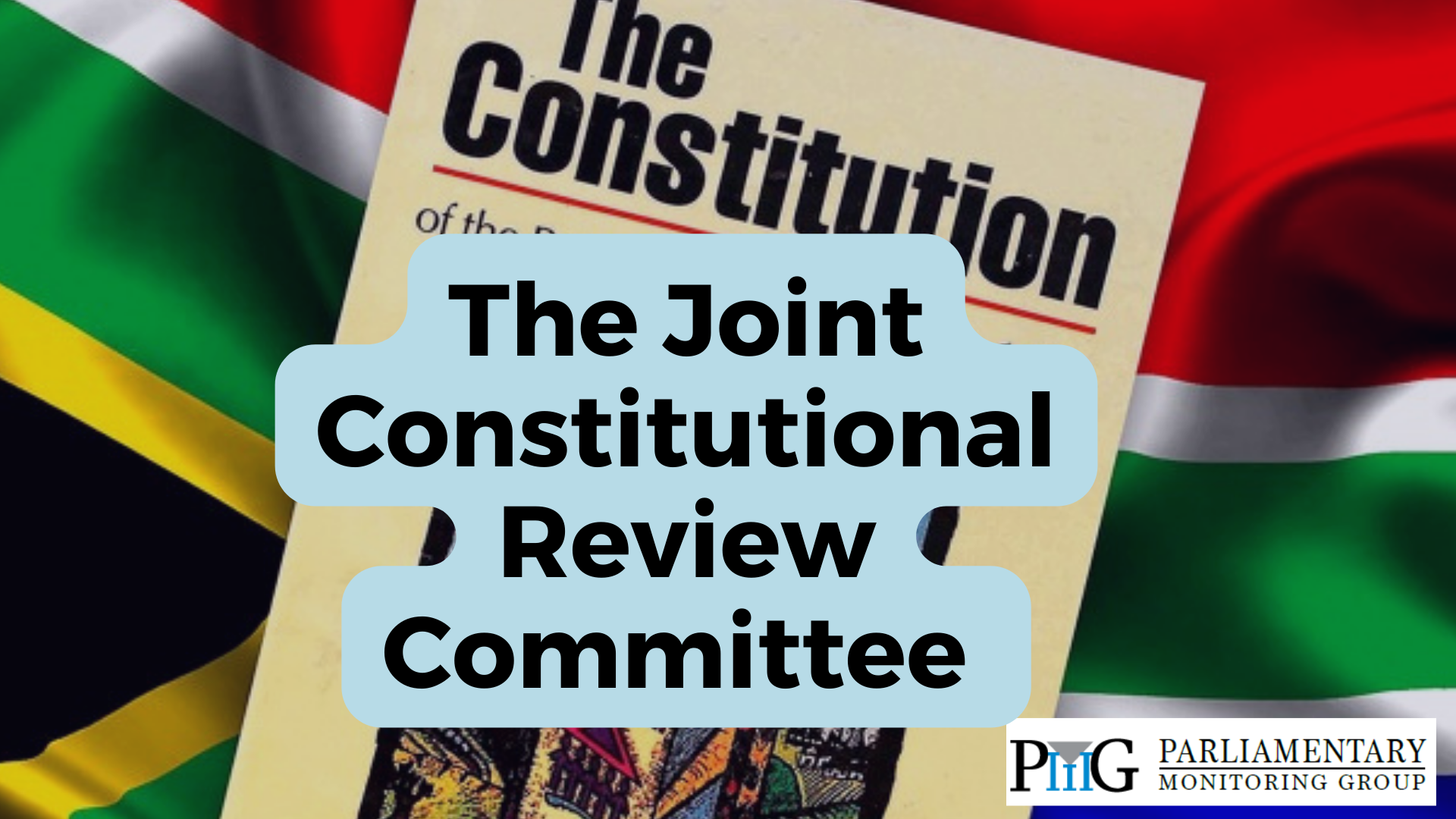The Joint Constitutional Review Committee

The Constitution is a ‘living document’. This means it can evolve and be moulded to take into account new circumstances. Like all modern constitutions, the South African Constitution provides for its own amendment by Parliament and prescribes procedures to effect such amendments. The procedure for amending the Constitution differs from that of other legislation. The Constitutional Review Committee plays a central role in the process.
How does the Joint Committee carry out its work?
Rule 102 (2) of the Joint Rules of Parliament requires the Joint Constitutional Review Committee to annually, during the month of May, by notice in the public media, invite the public, parliamentary committees, MPs and any organ of state to submit within 30 days, written representations on any constitutional matter that they feel needs to be reviewed.
After the comments submission window closes, the first step in the review process entails the tabling of all submissions received by the Committee and categorising them into three groups, namely: submissions which fall outside of the Committee’s mandate (Category 1); submissions which require parliamentary legal opinion and relevant stakeholder consultation (Category 2); and submissions which are ready for consideration by the committee (Category 3).
The categorisation process assists the Committee in determining the desirability of received submissions.
Since the Constitution is the supreme law of the land, constitutional amendments must clear a very high bar. This is also because once a constitutional amendment is passed by Parliament, it cannot be challenged on the basis that the amendment itself is unconstitutional. This was made clear by the Constitutional Court in its 2002 judgement, when it stated: “Amendments to the Constitution passed in accordance with the requirements of section 74 of the Constitution become part of the Constitution. Once part of the Constitution, they cannot be challenged on the grounds of inconsistency with other provisions of the Constitution. The Constitution, as amended, must be read as a whole and its provisions must be interpreted in harmony with one another. It follows that there is little if any scope for challenging the constitutionality of amendments that are passed in accordance with the prescribed procedures and majorities.”
The Constitution has been amended 17 times since it came into force in 1996.
Notably, the Joint Committee’s review process only goes as far as the Committee making recommendations to both Houses of Parliament on the desirability of submissions proposing amendments to the Constitution. Thereafter, it is up to Parliament to approve the Committee’s recommendations for referral to a relevant committee to come up with a draft Constitutional Amendment Bill.
Below is the Joint Committee’s review process in a nutshell:
- The Committee places a notice in the media, before the 1st day of May, inviting the public to submit written representations to it within 30 days, on any constitutional matter;
- The Committee processes all written submissions by classifying and categorising them into the constitutional provisions identified as requiring review;
- Public Hearings are held and the Committee consults and engages relevant stakeholders;
- Some written submissions are referred to parliamentary legal services for advice;
- The Committee thereafter deliberates on the desirability of all submissions received;
- A report is compiled with recommendations on the desirability of each submission and is then tabled in both Houses for consideration;
- Submitters are advised on the resolution/recommendation of the Committee on their submissions.
What are the issues raised by the public?
Our analysis of submissions sent to the Joint Committee over the years reveals that public submissions traverse an assortment of issues. The majority of submissions are in the form of complaints which fall outside the ambit of the Constitutional Review Committee. In processing these submissions, the Joint Committee, with the help of Parliament’s Legal Services, would then advise that most of these issues could be resolved by amending particular laws and not the Constitution itself as the Constitution was given effect to by means of laws- the Constitution is neither self-executing nor is it applied retrospectively.
In some instances, legal advisory would be of the opinion that submissions would have raised policy issues which could be best dealt with by portfolio committees. Some proposed amendments would either be already covered by existing legislation or fail to propose specific changes to the Constitution.
The following statistics are instructive: In 2020, 58 submissions were officially tabled before the Committee by the 30-day deadline (3 were duplicate submissions and 1 was a legacy submission stemming from the Fifth Parliament, and were thus eliminated). Of the 54 eligible submissions, 33 (57%) were disregarded as the Committee deemed they did not fall within its mandate, as the majority of submitters were expressing personal views on the state of varying affairs. There were 11 (19%) Category 3 deemed not desirable for a number of reasons, and the remaining 10 were category 2 submissions which required a legal opinion and the Committee is still finalising their processing and will ultimately pronounce on their desirability to amend the Constitution.
Some of the submissions have called for a return of the death penalty and the recognition of language dialects as official languages.
Highlights of the work of the Sixth Parliament’s Constitutional Review Committee
Since the beginning of the Sixth Parliament in May 2019, the Constitutional Review Committee has held seven meetings, five of those in 2020.
In its Legacy Report, the Fifth Parliament recommended the following specific issues for follow-up and consideration by the Sixth Parliament:
- House resolution adopting the recommendation for the amendment of Section 6(1) of the Constitution to include South African Sign Language as one of the listed official languages in this section.
- Consideration and finality of legacy submissions proposing a review of section 6 of the Constitution to reflect Sesotho sa Leboa as an official language as opposed to Sepedi. (2017 submission)
- Consideration of submission 16 of 2016 by Equal Education proposing a review of section 100 supported by legal advice to effect clarification for emphasis which allows for effective carrying out of the objectives of the section.
- House resolution on the amendment of Section 25 of the Constitution, to explicitly provide for state expropriation of land without compensation.
Of the four, only the House resolution on the amendment of Section 25 of the Constitution has been taken up by way of processing of the Constitution Eighteenth Amendment Bill which was rejected by the National Assembly in December 2021.
On the Sign Language matter, Parliament is yet to allocate this recommendation to the Portfolio Committee on Justice and Correctional Services for processing the necessary Constitutional Amendment to give effect to the identification of South African Sign Language as the 12th official language under section 6(1) of Constitution.
On the Sesotho sa Leboa submission, the submitters, in 2017, had asserted that Sepedi was incorrectly reflected in the Constitution and that Sesotho sa Leboa should be reflected instead. The Committee consulted extensively at the time and the experts advised that in the Sepedi version of the Constitution, the language is reflected correctly whereas in the English version of the Constitution, it is reflected in a different way. The matter was concluded in October 2020 with Committee Members agreeing they will carry out oversight engagements with the Pan-South African Language Board to see what the Board was doing to promote languages such as Sesotho sa Leboa, Khoi, Nama and San languages as referenced in Section 6(5) of the Constitution.
Lastly, the Equal Education submission proposing a review of section 100 was discussed towards the end of last year wherein the Committee recommended the submission be sent to the Department of Basic Education after legal opinion received by the Committee pointed out a lack of clarity on the S100 intervention roles and responsibilities. This lack of clarity resulted in confusion and diminished accountability amongst state organs during the S100 interventions to the detriment of subject of the intervention.
How to write a submission to the Constitutional Review Committee
In 2020, the Committee Co-Chairperson, in lamenting that a majority of submissions sent fell outside of the Committee’s mandate, had this to say: “If people did not understand what they needed to do when making submissions, then this was worrying because more people needed to engage on whether the Constitution should be amended.”
It is therefore important that, as is the case with all submissions to Parliament, submissions to the Joint Constitutional Review Committee be tailored in a clear and concise manner so as to add to the committee’s knowledge and understanding of an issue, which may influence its recommendations to the Parliament.
A clear step-by-step guide on How to write a submission
About this blog

"That week in Parliament" is a series of blog posts in which the important Parliamentary events of the week are discussed.
We host the latest posts of this blog, written by People's Assembly. You can find more on PA's blog.
About this blog

"That week in Parliament" is a series of blog posts in which the important Parliamentary events of the week are discussed.
We host the latest posts of this blog, written by People's Assembly. You can find more on PA's blog.
